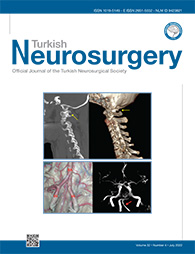2Baskent University Faculty of Medicine, Department of Neurosurgery, Adana, Turkey
3Baskent University Faculty of Medicine, Department of Paediatrics, Division of Pediatric Oncology, Adana, Turkey DOI : 10.5137/1019-5149.JTN.34490-21.3 AIM: To reevaluate the medulloblastoma cases according to histomorphological and molecular features, and to investigate the relationship between the prognostic factors of the new WHO classification by applying Beta-catenin, YAP1, GAP1, p53, and INI1 antibodies immunohistochemically.
MATERIAL and METHODS: This study includes 41 patients who have been diagnosed with medulloblastoma between 2007-2019 in pathology department. Immunohistochemically, p53, beta-catenin, YAP1, GAP1, and INI1 immune markers were applied, and the relationship between the results and the prognostic parameters was evaluated statistically.
RESULTS: When 41 patients were classified into WHO medulloblastoma histological subtype groups according to histomorphological features, 22 (53.7%) patients were classified as classical type, 11 (26.8%) patients as desmoplastic nodular type, and 8 (19.5%) patients as large cell/anaplastic type medulloblastoma. According to their molecular characteristics, 14 (34.1%) patients were in the Non-WNT/SHH group, 5 (12.2%) patients were SHH mutant, 17 (41.5%) patients were SHH wild, and 5 (12.2%) patients were in the WNT active group. There was no statistically significant correlation between age, gender, tumor size, recurrence, Ki67 proliferation index with molecular types and histopathological types.
CONCLUSION: In our study, metastasis at the time of diagnosis, histological large cell anaplastic type, immunohistochemical p53 positivity, molecular SHH mutant type were the statistically significant indicators of worse prognosis and shorter survival time.
Keywords : Medulloblastoma, Histological subtype, Molecular characteristic, Immunohistochemistry




